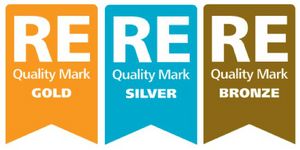What is Phonics?
Phonics is best understood as a body of knowledge and skills about how the alphabetic system works, and how to apply it in reading and spelling, rather than one of a range of optional ‘methods’ or ‘strategies’ for teaching children how to read. Our programme promotes the use of phonics as the route to reading unknown words, before any subsequent comprehension strategies are applied. It does not encourage children to guess unknown words from clues such as pictures or context, rather than first applying phonic knowledge and skills. The focus is on phonemes first and foremost.
Throughout the early years at Nutfield Church Primary School, phonics underpins the teaching of reading. This begins in EYFS, continues through KS1 and throughout KS2 when needed. All teachers at Nutfield Church School understand the impact quality phonics teaching can have.
To ensure this happens we want to give our pupils the best start possible and we do this by using a systematic synthetic phonics programme, Essential Letters and Sounds.
Through this we:
provide resources to enable teachers to deliver the programme effectively including sufficient decodable reading material to ensure that, as children move through the early stages of acquiring phonic knowledge and skills, they can practise by reading texts closely matched to their level of phonic attainment, that do not require them to use alternative strategies to read unknown words.
DfE Reading Framework July 2021
Phonics in the Early Years
Our SSP (Systematic Synthetic Phonics) programme follows a series of Phases (see below). Daily phonics sessions begin as soon as children start their Reception year. Learning to read and write letters develops phonemic awareness rapidly. Phonics sessions are between 15 to 20 minutes for the first few weeks and build in duration so that by the end of Reception the children may spend up to an hour a day in order to consolidate previous learning, learn new content and practise and apply what they have learnt.
Direct teaching sessions involve a routine so that teachers and children get to know what is coming next and minimum time is spent explaining new activities. Teaching and learning activities are interesting and engaging but firmly focused on intensifying the learning associated with the phonic goal. At each step, children have sufficient time to practise reading and writing with the grapheme-phoneme correspondences they have been taught.
The texts and books children are asked to read independently are fully decodable for them at every stage of the programme. In line with the National Curriculum This means they are composed almost entirely of words made up of grapheme-phoneme correspondences that a child has learned up to that point. The only exceptions should be a small number of HRS (hard to read and spell) words that the child has learned as part of the programme up to that point. In the early stages, even these should be kept to a minimum. Practising with decodable texts will help to make sure children experience success and learn to rely on phonic strategies. We teach our children to:
read aloud accurately books that are consistent with their developing phonic knowledge and that do not require them to use other strategies to work out words.
DfE Reading Framework July 2021
ELS Overview – Phase 1 to Phase 5
| Phase 1* | Phase 2 | Phase 3** |
Nursery/Pre-School Seven aspects:
|
Reception/Primary 1 Autumn 1 • Oral blending
|
Reception/Primary 1 Autumn 2, Spring 1 and Spring 2
|
| Phase 4** | Phase 5 including alternatives and lesser-known GPCs | Beyond Phase 5 |
Reception/Primary 1 Summer 1
|
Reception/Primary 1 Summer 2
|
Year 1/Primary 2 Summer, Year 2/Primary 3 and Key Stage 2
|
*Phase 1 of Letters and Sounds (2007) can be used in Nursery/Pre-School settings before starting ELS in Reception and can still be used throughout the school day in Reception. However, direct phonics teaching – the teaching of sounds, graphemes, word reading and vocabulary – must start from the very beginning of Reception.
**Phase 3 of ELS covers more than just the Phase 3 graphemes – we introduce some challenge from Phase 4 (in the form of adjacent consonants) alongside the Phase 3 teaching to extend children’s sounding out and blending skills.


